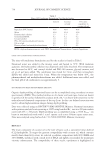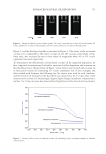721 PHYSICOCHEMICAL PROPERTIES OF TEXTURED HAIR solvent-extracted hair (to remove all lipids) for the three hair types should be carried out. The reported absorption-desorption isotherms were obtained for one tress from one lot of hair for each sample. To ensure reproducibility, we conducted the same series of tests with a second set of samples and obtained similar results. Diffusion coefficients were calculated using Fick’s second law of diffusion, which we use to describe diffusion of water vapor into (absorption) the hair fibers during a DVS experiment (39). Equation 2 is a simplified form of Fick’s second law of diffusion for a cylindrical material: m m Dt r2 ∞ = 4√ π (2) where m is the mass at any given point in the relative humidity step, m ∞ is the mass at equilibrium (essentially when the plateau in mass change is reached), t is the time, r is the radius of the fiber, and D is the diffusion coefficient. The data obtained from the DVS experiment were plotted as m m∞ as a function of √t r , which allowed for the determination of the linear slope at the beginning of the plot ( m m∞ 0.5). The diffusion coefficient was calculated using the following relationship in units of centimeters squared per second (cm2/s): D slope2 = ⋅ π 16 (3) Table I contains the diffusion coefficients calculated at each humidity value for absorption of water into the hair. Since Caucasian hair is oval shaped and African hair is elliptical, diffusion coefficients were calculated for the major and minor radius dimensions, and these values were averaged to obtain the diffusion coefficients reported in the table. The major and minor axes radii were obtained from FESEM measurements of hair cross-sections (at least 50 Table I Diffusion Coefficients Determined at Each Humidity Step During DVS Absorption Experiments % RH Africana Caucasian 10 7.50 × 10−9 2.10 × 10−8 20 9.50 × 10−9 2.60 × 10−8 30 9.50 × 10−9 2.55 × 10−8 40 7.50 × 10−9 2.60 × 10−8 50 6.50 × 10−9 2.15 × 10−8 60 3.40 × 10−9 1.17 × 10−8 70 4.10 × 10−9 1.02 × 10−8 80 5.55 × 10−9 1.50 × 10−8 90 7.50 × 10−9 2.20 × 10−8 a The African hair reported is tightly curled African hair.
722 JOURNAL OF COSMETIC SCIENCE fibers). Overall, we find that the diffusion coefficients for Caucasian hair are greater than those obtained for African hair. Again, this could be due to the greater lipid content in African hair, which would impede the absorption of water. Notably, these diffusion coefficients are in agreement with previous studies published in the literature in the range of 10−8 to 10−9 cm2/s (36). Please note that data are only provided for tightly curled African hair in Table I, and not extremely tightly curled African hair, because we did not carry out cross-section experiments (to measure fiber diameters with scanning electron microscopy) for this hair type. MORPHOLOGY OF AFRICAN HAIR CROSS-SECTIONS The highly elliptical character of African hair cross-sections has been known for some time, although detailed analyses have yet to be completed (24,40,41). In this work, we provide some insight into the morphological and fine structure of African hair. Figure 9 presents FESEM micrographs of cross-sections of Caucasian and tightly curled African hair, which clearly demonstrate the large differences in hair ellipticity between the two hair fiber types, similar to the FTIR spectral image in Figure 7. Again, extremely tightly curled African hair was not analyzed by this method due to its extraordinarily curly and kinky nature, which prevented us from carrying out the cross-sectioning procedure. Typically, the dimensions and shape of hair along the shaft (or hair axis) are measured using a laser micrometer while rotating the fiber and examining several points along the axis of a single fiber. The advantage of this technique is that good statistics can be obtained for a selected number of fibers (usually at least 100). For comparison, we conducted measurements of the small- and large-diameter axes from the FESEM micrograph, which allowed us to calculate the cross-sectional area and ellipticity index (EI). The cross-sectional area of Caucasian and tightly curled African hair was found to be 4,677 μm2±1,429 and 6,206 μm2 ± 1,223, respectively. These data suggest that tightly curled African hair might have a slightly larger cross-section than Caucasian hair. Values in the literature of 3,857 μm2±132 and 4,274 μm2±215 for Caucasian and tightly curled African hair, respectively, corroborate these results (40). EI is calculated by taking the ratio of the diameter measurements of the major and minor axes. As expected, the EI of Caucasian hair (1.34 ± 0.19) was lower than tightly curled African hair (1.98 ± 0.28). Our EI data are in agreement with measurements previously reported in the literature Figure 9. FESEM micrographs of cross-sections of (A) Caucasian and (B) tightly curled African hair.
Purchased for the exclusive use of nofirst nolast (unknown) From: SCC Media Library & Resource Center (library.scconline.org)






































































































































